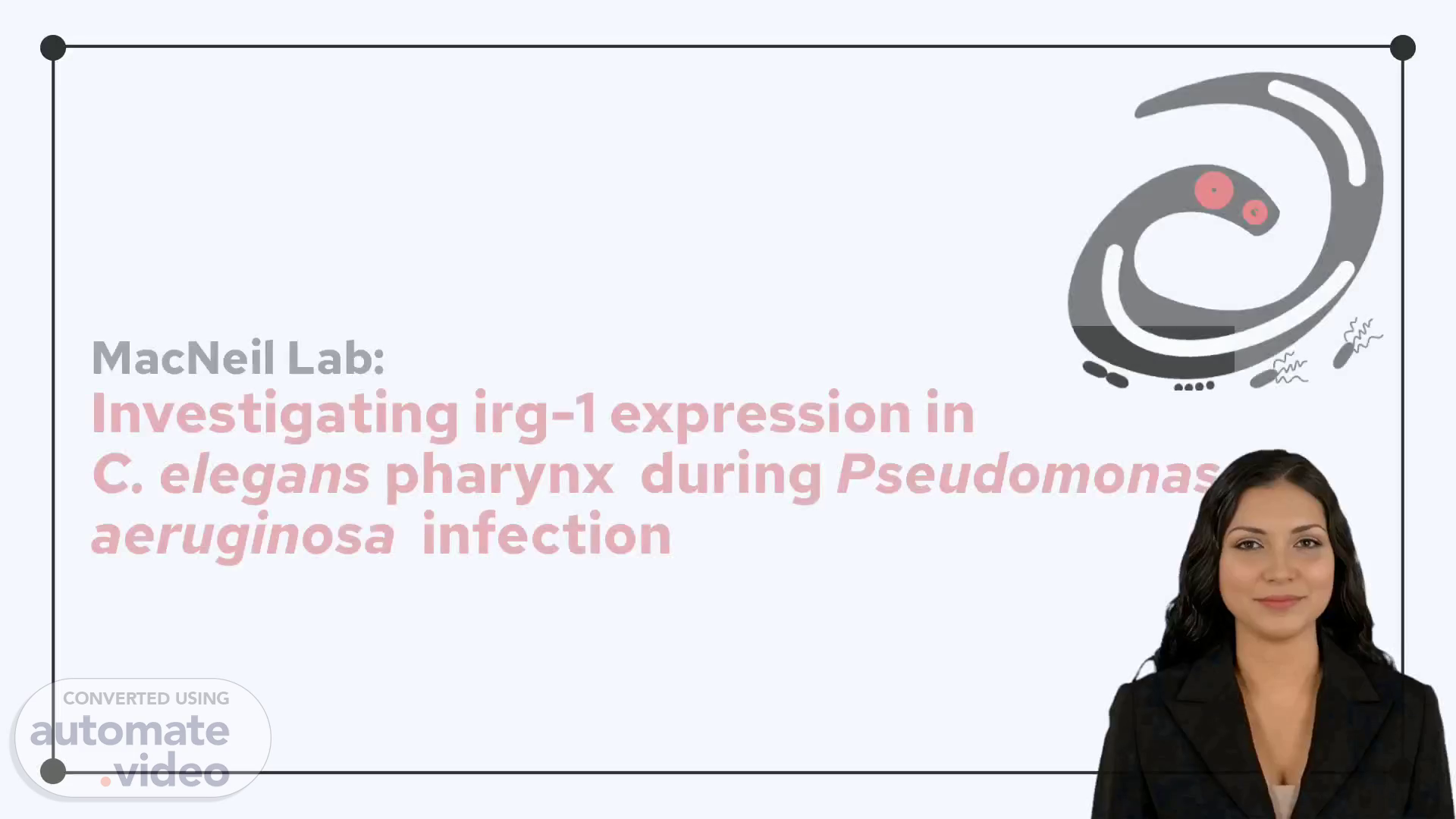
Page 1 (0s)
[Virtual Presenter] Good Evening everyone! Today we will be discussing the MacNeil Lab's research on the expression of irg-1 in C. elegans pharynx during Pseudomonas aeruginosa infection. On August 17th, we invite you to join us to learn more about this exciting scientific breakthrough. Our presentation will take you through the research process, from initial planning to the final results. We look forward to your questions and comments!.
Page 2 (31s)
[Audio] C. elegans is an extremely useful species to investigate the relationship between a unicellular organism and a multicellular one. It is conveniently designed to be genetically manipulated, which leads to a better understanding of how genes shape these interactions. Moreover, this species is a bacteriovorus, meaning it can consume bacteria. Furthermore, its relatively short lifespan and three-day reproductive cycle aid in the research of immunity pathways. Lastly, its transparency permits researchers to utilize techniques like fluorescence to analyze both the host and the pathogen..
Page 3 (1m 15s)
[Audio] Pseudomonas Aeruginosa is a bacterium that has been known to cause infections in plants, invertebrates, and mammals. Its numerous virulence factors target conserved host processes, and in humans, it is known to cause infections in the blood, lungs, and other parts of the body. The MacNeil Lab's summer work term will examine Irg-1 expression in the C. elegans pharynx during Pseudomonas aeruginosa infection. Their findings are expected to be presented on August 17, and it will be interesting to see the outcome of their research..
Page 4 (1m 52s)
[Audio] The MacNeil Lab is investigating the mechanisms of Pseudomonas aeruginosa infection in the nematode C. elegans. Specifically, this summer work term they will be looking into the expression of the gene irg-1 in the C. elegans pharynx during P. aeruginosa infection. On August 17th, they will present their findings and predictions for the future of the project..
Page 5 (2m 18s)
[Audio] At the MacNeil Lab, our Summer work term project will investigate the expression of the gene irg-1 in the C. elegans pharynx during Pseudomonas aeruginosa infection. Specifically, we will investigate the mechanisms of slow and fast killing and host colonization of the bacterium. We will also investigate the secreted exotoxins of P. aeruginosa, and how it affects the iron homeostasis of the host organism. We will use a solid and liquid media to simulate the infection and analyze our data. Join us on August 17 to hear the results of our research." Our research team at The MacNeil Lab is looking forward to sharing our findings of the expression of the gene irg-1 in the C. elegans pharynx during Pseudomonas aeruginosa infection. Through our research, we will investigate the mechanisms of slow and fast killing and host colonization, as well as the impact of the bacterium’s secreted exotoxins on iron homeostasis. Our results will be presented using a solid and liquid media to simulate the infection and analyze our data. Join us on August 17 to learn more about our study..
Page 6 (3m 34s)
[Audio] We will have a slide showing a comparison of immune expression in solid and liquid media. According to Dunbar et al. 2012, the IRG-1 gene was not expressed by C. elegans when infected with Pseudomonas aeruginosa in solid media. However, IRG-1 gene was expressed when the same species was tested in liquid media. We plan to further investigate this difference in expression during our Summer work term, and results of our research will be presented on August 17..
Page 7 (4m 9s)
[Audio] I am Mercedes DiBernardo, a member of the MacNeil Lab. As part of our summer work term, we are exploring the expression of the iron-regulatory gene irg-1 in the C. elegans pharynx, when infected with Pseudomonas aeruginosa. Our hypothesis is that P. aeruginosa grown in liquid produces siderophores that, upon iron sequestration, will disrupt the mitochondrial network in the pharyngeal muscle, leading to changes in irg-1 expression. On August 17, we will present our findings at an upcoming event. We are eager to share our work and gain insight from others..
Page 8 (4m 51s)
[Audio] I am responsible for crossing C. elegans strains, optimizing liquid assay protocols, and performing RNAi knockdown experiments for this project. Additionally, I am taking part in the design of the experiment to identify key parameters that will affect the outcome of the project. All of this is for the purpose of investigating the expression of irg-1 in C. elegans pharynx during Pseudomonas aeruginosa infection..
Page 9 (5m 20s)
[Audio] I was in charge of cloning during my work term. I cloned a plasmid which contained nucleoproteins like SARS and Tau proteins. This ability was extremely useful for our research of irg-1 expression in the C. elegans pharynx during Pseudomonas aeruginosa infection. Learning the cloning technique enabled me to make a valuable contribution to the MacNeil Lab's Summer work term investigation..
Page 10 (5m 49s)
9 VVLIO ouvv 9 uone6n o vvno OLIVV 9 a6eneal. 9 VVLLO OLIVV 9 uone6n 91YV110 abet,eal &O.
Page 11 (5m 59s)
[Audio] We are greatly appreciative of the MacNeil Lab for their support throughout this project. We would like to especially thank Dr. Lesley MacNeil and our team members Hiva Mesbahi, Kim Pho, Mercedes Di Bernardo, Germain Sophie Ngana, Sommer Chou, Salah Khan, and Rebecca Snow for their tremendous efforts in examining irg-1 expression in C. elegans pharynx during Pseudomonas aeruginosa infection. Their commitment and help has been instrumental in completing this project..
Page 12 (6m 32s)
[Audio] The MacNeil Lab will discuss the results of their investigation of irg-1 expression in C. elegans pharynx during Pseudomonas aeruginosa infection at the upcoming seminar on August 17th. The research was conducted based on important studies, such as Dunbar, T. L. et al., published in Cell host & microbe in 2012, and Vilaplana, L., & Marco, M. P., published in Analytical and Bioanalytical Chemistry in 2020. Our team is excited to share their findings and provide valuable insights..